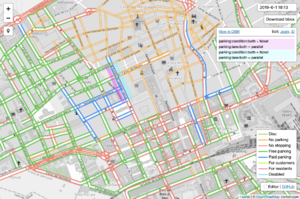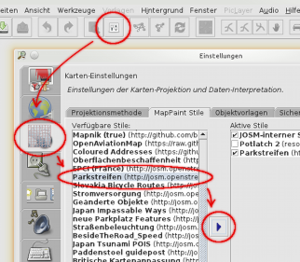Key:parking:lane
| Description |
|---|
| Cars parking on the street |
| Group: parking |
| Used on these elements |
| Requires |
|
| Useful combination |
|
parking:lane:both parking:lane:left parking:lane:right parking:condition:both parking:condition:left parking:condition:right parking:lane alone (do not use) |
| Status: approved |
| Tools for this tag |
|
The keys parking:lane=* and parking:condition=* define whether or not the highways themselves have parking, on which sides, and with which conditions.
Describing highway parking comes down to two different properties:
- If one is allowed to park, how is one supposed to place the vehicle when parking?
- Under what conditions one may or may not park there?
To this end, we use two tags. A prohibition to park, or a prohibition to stop excludes any parking, so we can have the vehicle orientation and the aforementioned cases as values of one tag. If parking is allowed, we then have to use some other key to describe the conditions for parking.
It should not be required or even encouraged that the ways would be split for short implicit parking prohibitions; that is just before and after a junction or a driveway.
Parking spaces
The parking:lane tag is used to describe the "physical" properties of the road. This means space properties.
The left and right hand side are differentiated by having either only a parking:lane tag appended either only :both or a combination of parking:lane tags appended with :left or :right. It is intentional to use left and right instead of forward and backward, because parking space is about location, not direction. E.g., a one-way has sometimes parking space at the left and at the right hand side, but no "backward" parking. See Forward & backward, left & right.
Please note that the latter three are considered "physical" tags, this means: parking is not possible, so no parking:condition tag (see below) is required in those cases.
| Key | Value | Description |
|---|---|---|
| highway | * | Generic tag for the highway in question. |
| parking:lane:side
side is always left, right, or both. |
parallel | They must park parallel to the road. |
| diagonal | They must park diagonally; AKA angle parking or echelon parking. | |
| perpendicular | They must park at a right angle; i.e., the front or back of the vehicle pointing straight towards the road center line. | |
| marked | There are only some parking spaces available that are individually marked. | |
| no_parking | No regular road user is allowed to park on the road. They may stop, though, to for example pick up/drop off a passenger, unload cargo or for other reasons as laid out in the local legislation. Equivalent to "loading zone" rules in the United States. | |
| no_stopping | No regular road user is allowed to stop their vehicle, except when traffic conditions require him to do so. Equivalent to "no parking" rules in the United States. | |
| fire_lane. | In countries where such exist, an extra sign indicating a lane that must be kept clear for possible fire engines, or other emergency vehicles: in a sense equal to, but stricter than a no_stopping. |
Parking position
Sometimes the parking on the street is allowed at the edge of the driving lane, at other times there is a painted, dedicated strip at the edge of the road, and sometimes one must park on the high side of the kerb stone; this can be recorded with the key: parking:lane:side:type.
type takes values of parallel, diagonal or perpendicular, as applicable.
Known values are:
- on_street
- half_on_kerb
- on_kerb
- lay_by —
 Rest area#Lay-bys
Rest area#Lay-bys - painted_area_only
- shoulder —
 Shoulders are hard sections of the road area not normally meant to be driven on, they can be of the same surface as the way or of a degraded or use-graded surface; requires shoulder=yes|left|right|both
Shoulders are hard sections of the road area not normally meant to be driven on, they can be of the same surface as the way or of a degraded or use-graded surface; requires shoulder=yes|left|right|both
Examples
- parking:lane:both=parallel: both on the left and right hand side parallel parking is possible.
- parking:lane:right=perpendicular: on the right hand side you can park perpendicularly.
- parking:lane:both=marked: there are only some parking spaces available that are individually marked.
- parking:lane:left=fire_lane: stopping is not possible on the left hand side due to fire considerations. (Normally there will be a sign for this.)
Possible enhancements
Specifying the maximum capacity for a given stretch of parking (especially for parking:lane:side=perpendicular).
Parking conditions (terms)
Note: it has been suggested to migrate to the new style conditional restrictions style tagging. Please discuss on Talk:Key:parking:lane.
The parking:condition tag describes the legal properties of the parking space. The left- and right-hand side are specified by either a combination of tags appended with :left, :right, or a single tag appended with :both.
| Key | Value | Description |
|---|---|---|
| highway | * | Generic tag for the highway in question. |
| parking:lane:side
side: left, right, or both. |
parallel, diagonal, perpendicular. | For other types, the condition tag makes little sense. |
| parking:condition:side
side: left, right, or both. |
free | No additional information is required. |
| ticket | To be discussed. Maybe add a parking:condition:side:fee_per_hour=1 € tag. | |
| disc | Add a parking:condition:side:maxstay=2 h tag. This means you may park here for up to 2 hours. | |
| residents | Add a parking:condition:side:residents=A tag. This means "parking only for residents with permission A" (With A being the identification of the permission). 
| |
| customers | No additional information is required. This means you are only allowed to park here if you are a customer of the shop that owns this parking space (or a visitor of a site, or a guest of a hotel, or similar). | |
| private | No additional information is required. This means you are only allowed to park here if you rented the parking space (or have a permission of the owner). | |
| disabled? | Usually, this parking space is not about free or paid. It requires being related to disabled persons or to have such permission. |
Type of vehicles
If the condition is valid only for some vehicles, use
- parking:condition:both:vehicles=motorcar or
- parking:condition:both:vehicles=goods; bus
Residential permits
Area based residential permits often carry some sort of letter or code identifying the area wherein they are valid; this can be recorded using the key: parking:condition:side:residents.
When parking is requires a ticket or a residential permit, the following combination is often used:
More usual OSM tagging convention would, for the same purpose, suggest:
- parking:condition:both=ticket;residents
- parking:condition:both:residents=*
Time dependence
In many occasions, parking conditions are time limited, especially for disc and residents parking. This can be specified by using the following tag: parking:condition:side:time_interval. Values specify both days and times, plus it can be multiplied. It uses the same syntax for values as opening_hours.
| Key | Value | Description |
|---|---|---|
| parking:condition:side:time_interval
side: left, right, or both. |
<opening_hours> | A date and time specification as per opening_hours, such as Mo-Fr 12:00-14:00 |
The format is complicated to define technically, but easy to understand by examples:
- 12:00-14:00 means: "every day from 12:00 until 14:00".
- Mo-Fr 00:00-24:00 means: "every weekday (except Saturday and Sunday)".
- Su 20:00-06:00 means: "Sunday night from 20:00 until (Monday) 06:00".
Intervals may be joined by semicolons with optional whitespace:
- Mo-Fr 09:00-20:00; Sa-Su 09:00-14:00 means: "Weekdays 9 to 20, and weekends 9 to 14".
With multiple differing conditions
In the simplest case you have free parking at night, and ticket parking at day on workdays; for example,
- parking:condition:right=ticket
- parking:condition:right:time_interval=Mo-Fr 09:00-19:00
- parking:condition:right:default=free
Sometimes specifying one default condition is not enough. In these cases we end up with an abundance of tags, for example:
- parking:lane:right=parallel
- <empty>
- parking:condition:right=no_stopping (read: no stopping during morning rush hour; US read: no parking during morning rush hour)
- parking:condition:right:time_interval=Mo-Fr 07:00-09:00
- 2
- parking:condition:right:2=disc (read: otherwise, at daytime, short term parking only)
- parking:condition:right:2:maxstay=30 min
- parking:condition:right:2:time_interval=Mo-Fr 09:00-18:00
- default
- parking:condition:right:default=free (read: and free parking at night)
In this example, we couldn't use plain parking:lane:right=no_stopping, as parking is allowed at some times of the day.
Maximum stay
Use parking:condition:side:maxstay to specify maximum stay limits; especially applicable for disc parking. It takes should take values precisely as per maxstay.
Services
- zlant.github.io parking lanes viewer
- Dynamic map Parking properties in OpenStreetMap (uMap)
crite.net(currently broken)
Examples
Some pictures of different roads and how to tag them are in Key:parking:lane/Examples.
Using with JOSM
There a simple tagging preset and a style file for JOSM editor available. You can activate them in Preferences > Map settings.
JOSM map display (MapPaint) is now able to show direction dependent styles, so it shows the parking lanes and conditions for each side of the way. The colours shown in JOSM match the ones on the parking map.
- Parking ticket vending machines
- amenity=vending_machine + vending=parking_tickets


